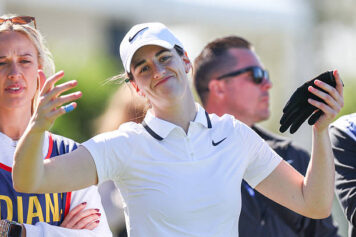Serena won.
Despite the jeers that rained down when she took the court and in defiance of boos after she scored match point, Serena Williams made an incredible two-set comeback to beat Kim Clijsters in the final at Indian Wells.
Then she went to her locker room, cried, and hasn’t returned for 14 years. Today, Serena returns to the scene of her biggest triumph and disappointment in tennis. Shes no longer a 19-year-old upstart who might be rattled by heckling that the Williams family has always maintained was motivated by racism. Williams is now the GOAT of womens tennis, the number one player in the world. She has the clout to use her return to the site of her worst day in tennis to raise money for
Serenas confidence and clout in going back to Indian Wells marks how much has changed in the broader sports world around her since 2001. Nothing more embodies those changes than the drastic divergence of careers between she and another transformative Cablanasian black athlete who was only an upstart in the early aughts, Tiger Woods. Serena and Tiger dominated the decade like no other athletes, taking over big money sports that had little to no relationship with young black athletes or fans. The thing that bound them, at least to observers, was their success. Where they differed was in their perspective and handling of race. Serenas boycott of Indian Wells and her Crip-Walking at Wimbledon were forms of protest and cultural signifiers that Tiger would never have touched.
Woods handled his success, and the racism hurled at him because of it, differently. His rebuke of Sergio Garcia for his ridiculous fried chicken comment may have been more about their personal feud than stamping out bigotry in his sport. Fuzzy Zoeller said something worse in 1997:
Woods responded with a tepid statement that almost gave Zoeller a pass. [H]aving played golf with Fuzzy, I know he is a jokester; and I have concluded that no personal animosity toward me was intended, the statement read in part.
Tiger even gave his former caddie, Steve Williams, the benefit of the doubt after Williams said at a party full of other caddies that hed wanted to shove it up that black arsehole after Williams new golfer, Adam Scott, beat woods at a tournament. Woods defended the dig, saying Stevies certainly not a racist.
So Tiger and Serena diverged early on in how they handled race. The course of their careers wouldn’t split until years later, in 2009. That was the last year that both stars finished ranked number-one in the world in their respective sports. The way things are going, its probably the final time that ever happens. Tiger and Serena, for two decades savants who excelled at sports that had been lily white, have now diverged as far as possible. Williams, returning to Indian Wells, looks like neither age or opponent can slow her down. Her serve remains the best in the business. By every measure, with the exception of not having won a Grand Slam, shes made the case for being called the G.O.A.T. in womens tennis. Theres little doubt that for all but the most ardent tennis fans, she already is.
Woods is headed in a drastically different direction. He finished ranked first in the world in 2013, but only held that slot for a short time. That was buttressed with a 23rd ranking in 2011, third in 2012 and 17th in 2014. Right now, Woods is ranked 62nd on the PGA Tour. Last week he pulled out of the Farmers Insurance Open, the third time in 11 months that hes withdrawn from a tournament without finishing. At age 39, a four-major gap between he and Jack Nicklaus and a bad back, Tiger wont finish his career more than a distant second to the throne, either it titles or the sports worlds collective memory. The fall from grace has been as dramatic as was his rise.
That isnt to say that Tiger wont always be golf royalty. Hes earned every stripe on his sleeve, from being the youngest to win a green jacket to his larger importance to his sport or the culture. Some may still find joy in quibbling over his muddled racial self-identification, made at an age when most people are three or four evolutions from full maturity. Regardless of what Woods ever called himself (or what anybody thought about it), he was still the blackest man at any major tournament in a generation. He still brought with him a new horde of fans and aspiring players. Tiger made golf cool. Made it relatable. Tiger being on the course meant you could try selling Buicks to people would’ve otherwise looked at an Escalade (at least until he showed up to a tournament in a Porshe and then crashed his own Escalade into a tree).
The biggest impact of the career arcs of Woods and Williams diverging so dramatically is that today, only one of them still matters in the American zeitgeist. Its arguable that for the first decade of the millennium, they were the most culturally-relevant duo in the world — though granted neither would accept the comparison. American football and basketball players and Europes footballers may have had greater individual fan bases but outside of Beckham, no other athletes could loosen corporate sponsors purse strings so easily or command so much space in the public consciousness. Remember Serenas catsuit? Tigers Vanity Fair cover?
One of those things would still be significant today; Serena C-Walking on Sharapova at Wimbledon in 2012 still meant something. Tiger, for the most part, is now only discussed in two contexts: what he can no longer do on the golf course and what he used to mean on it. History wont judge him nearly as harshly as the present. But for now, Serenas star burns brighter than ever now that it no longer shares the same sky with Tigers faded one.
Celebrate Serena. You’ve earned it.



